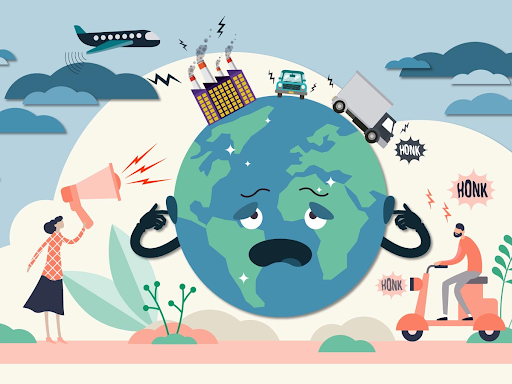Noise Pollution, the Unheard Menace
Introduction:
Noise pollution is an inexorably inescapable and frequently misjudged ecological issue that represents a critical danger to human prosperity and the normal world. Characterized as undesirable or hurtful sound that upsets the typical acoustic climate, noise pollution has become a quiet menace in our modern society. With urbanization, industrialization, and transportation frameworks on the ascent, noise pollution levels have flooded, influencing our physical and emotional wellness and the equilibrium of environments. This thorough investigation plans to reveal insight into the different aspects of noise pollution, its source’s impacts on people and networks, and potential relief methodologies. Understanding the gravity of this issue is fundamental for conceiving practical arrangements and guaranteeing a calmer, better future for all.
Main Body
1. Information about noise pollution
1. Data about noise pollution
Noise pollution, or sound pollution, is an unreasonable measure of undesirable or problematic sound that impedes day-to-day existence and brings down one’s satisfaction. Decibels (dB) are units of estimation for sound, and noise pollution frequently alludes to sounds stronger than whatever is viewed as OK. This can have various negative impacts.
2. Noise pollution sources
The origins of noise pollution are numerous. Some main offenders in the transportation systems are the roads, aeroplanes, and railroads. Additionally, loud noise is produced by commercial operations, building sites, and even leisure activities like concerts and sporting events. The situation has only been made worse by the recent fast urbanization and technology improvements, which have increased the noise footprint in urban and suburban areas.
3. Health Consequences
Noise pollution is dangerous to your health and is more than just an annoyance. Long-term exposure to loud noises can cause a variety of health and psychological problems. Living in noisy places frequently negatively affects sleep, stress levels, and the risk of cardiovascular diseases. Additionally, youngsters exposed to persistent noise may struggle academically and grow cognitively more slowly.
4. Effects on the environment
Noise pollution affects not only human health but also the environment. Due to constant human-made noise, wildlife, particularly in urban settings, experiences heightened stress and confusion. Birds change their singing, underwater noise affects marine life, and noisy surroundings can even hinder plant growth.
5. Economic Implications
The financial burden of noise pollution is considerable. A few examples include decreasing property prices in noisy areas, healthcare costs associated with health issues brought on by noise, and decreased worker productivity due to noisy workplaces. The tourist and hospitality sectors are particularly impacted by noise pollution since it discourages travellers from going to busy areas.
6. Legislation Actions
Governments and local bodies have acknowledged the need to mitigate noise pollution. Several laws and ordinances have been established to restrict noise pollution from businesses, vehicles, and construction. Though enforcement and compliance issues still exist, more severe standards are required to address this problem successfully.
7. Noise Reduction Techniques
A diversified strategy is needed to combat noise pollution. Noise levels can be decreased using noise barriers, acoustic insulation, and quieter transportation methods. Public awareness campaigns can also encourage individuals to adopt responsible noise habits by reminding them to be conscious of their noise emissions.
8. Technological Solutions
Technology advancements give hope for noise reduction. Electric cars and other quieter modes of mobility are becoming increasingly popular. Architectural advancements in building design and noise-cancelling headphones both help limit noise exposure.
9. Social and Psychological Consequences
Noise pollution has a significant negative influence on our psychological and social well-being in addition to our physical health. Chronic noise exposure may cause heightened irritation, aggressiveness, and poor concentration. Additionally, it can sour interpersonal bonds and spark disputes amongst neighbours, roommates, and communities. Noise pollution can weaken neighbourhood social structures and lower the standard of living in general.
10. Effects on Education
The negative consequences of noise pollution on schooling are one frequently disregarded side effect. Schools that are close to busy streets or industrial areas have particular difficulties. Students who struggle to concentrate in noisy settings may perform worse academically. It might be necessary for teachers to speak louder, which could cause vocal cord strain and lower teaching effectiveness. Educational institutions must implement noise-reducing techniques like acoustic insulation and double-glazed windows to establish favourable learning environments.
11. Vulnerable Groups
It is crucial to understand that some demographic groups are more susceptible to the negative impacts of noise pollution. For instance, noise-induced stress and the health issues it causes are particularly dangerous for the elderly and those with preexisting diseases. Additionally, because loud industry and transportation hubs are generally located in economically poor areas, disadvantaged populations frequently endure a disproportionate amount of the burden of noise pollution. Fighting noise pollution requires addressing issues of environmental justice.
12. Cultural considerations and the global perspective
Noise pollution is a problem that affects the entire world, not just certain cities or geographical areas. The tolerance for noise varies among cultures, and what is considered excessive noise in one community may be tolerable in another. As a result, controlling noise pollution calls for a comprehensive strategy that considers cultural perspectives and regional conditions. Regulating noise pollution from transboundary sources, such as international air travel and maritime shipping, also requires international cooperation.
13. Noise-reduction technological innovations
Technology constantly evolves, opening up new noise control and reduction opportunities. The emergence of noisier means of transportation, such as electric and hybrid cars, promises to considerably reduce noise emissions from road traffic. Additionally, the impact of noise pollution on communities can be reduced by incorporating noise-cancelling technologies into urban planning and architecture, such as intelligent sound-absorbing materials and green infrastructure.
14. Urban Design and Planning for Sustainability
Urban planning and design are essential factors in the fight against noise pollution. Municipalities and cities can implement sustainable urban design techniques that prioritize noise reduction. Green spaces, pedestrian-friendly areas, and mixed-use developments that reduce noise-producing activities are examples of this. Additionally, zoning laws that separate commercial from residential areas might lessen the amount of noise inhabitants are exposed to.
15. Community involvement and public awareness
Driving change requires increasing public awareness of noise pollution. Communities can start noise reduction initiatives by organizing neighbourhood-level campaigns, pushing for noisier infrastructure, and encouraging noise-aware behaviour. Engaging in conversations about noise issues with local authorities and businesses promotes teamwork and makes implementing effective noise control measures easier.
Conclusion
In conclusion, noise pollution is a complex and pervasive problem beyond simple irritation and impacts our health, social cohesion, educational systems, and general quality of life. It is more important than ever to address this problem head-on as our world becomes noisier daily.
A holistic approach is required to address the wide range of effects of noise pollution, from its detrimental effects on physical and mental health to its strain on interpersonal relationships and educational outcomes. Vulnerable groups and the cultural intricacies around noise tolerance underscore the necessity for sensitivity and inclusivity in addressing this global issue.
The promise of technological advancements includes the possibility of quieter architecture and transportation. Green infrastructure, zoning laws, and sustainable urban design can create more peaceful and habitable communities.
However, community involvement and public awareness remain the most critical change agents. We may encourage a global trend toward a more harmonious soundscape by acknowledging noise pollution as a shared responsibility and pushing for quieter places.
The end of the fight against noise pollution demonstrates our dedication to building quieter cities and societies that are healthier, happier, and more united. We can ensure that the symphony of our lives is made of tranquillity and well-being by effectively combating noise pollution, which will benefit both present and future generations.
https://sabitasingh.me/a-stitch-in-time-saves-nine/(opens in a new tab)




